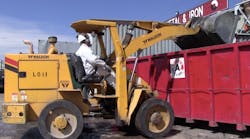From mining to metal smelters and glass plants to fertilizer operations, extreme temperatures and corrosive elements can take a heavy toll on industrial material handling equipment such as wheel loaders and forklifts. With many of these facilities running continuous multi-shift schedules, light-duty, commercial-grade material handling equipment can wear out prematurely.
Bill Barns, a project manager at Langeloth Metallurgical Company (LMC), learned that lesson a long time ago. LMC is one of the world’s largest ferromolybdenum producers, and the first site to commercially convert molybdenite concentrates to technical molybdic oxide.
At LMC’s Langeloth, Pa. plant, six multi-hearth furnaces called “roasters” can operate at temperatures up to 1400 °F to provide flexibility in processing various metal-bearing materials. To keep the plant operating 24/7 year-round, a fleet of wheel loaders on its fifth floor must continuously scoop up concentrated mine ore and dump it into the feed hoppers of the roasters, which process the ore into finished product.
“Our loaders [Waldon 4500Bs] have to feed the roasters continuously without fail,” says Barns. “Light-duty, commercial equipment cannot reliably do that because they’re not intended for hard 24/7 industrial use in confined areas.”
Managers in harsh industrial environments like Barns’ are finding that by lengthening the life of material handling equipment and increasing its reliability with severe duty designs specifically intended for their applications, they can reduce capital costs and improve production. This approach can not only eliminate premature equipment repair and replacement costs but also minimize production downtime due to unscheduled equipment breakdown.
While ordinary soil weighs about 60-80 lbs. per cubic foot, LMC’s ore weighs about 150 lbs. per cubic foot, according to Barns. “With our heavy loads and continuous use, we’re putting more stress on the frames,” he says. “If we used light-duty, commercial equipment, we would be breaking a lot of lift cylinders and main frames. We typically get about five to seven years of continuous 24/7 use out of our equipment before we resell them for light-duty, commercial work.”
Barns’ loaders’ extra heavy duty frames, 2-inch thick articulating frame plates, and simple drive train contribute to their longevity. “Our fleet of seven severe duty loaders does the work of a least ten to twelve light-duty, commercial loaders because we would probably need that many light-duty units to keep our roasters reliably fed.”
But space restrictions within the plant building – which was built almost a century ago with low ceilings, multiple columns and narrow access points – called for compact, low-profile loaders capable of tight turns and fitting into a maintenance elevator .
“Since light-duty, commercial loaders are typically made for outdoor use with higher cabs, bigger tires and bodies, many wouldn’t clear our fifth-floor ceiling or fit in a maintenance elevator without lengthy disassembly,” says Barns. “With our roasters’ feed bins in different positions, there’s also a need for better maneuverability.”
According to Barns, even skid steers known for their small size lack desired maneuverability in this setting. This is because their fixed frames do not turn quickly, and their wheels tend to lock up and skid, which is less than ideal for maneuvering in confined spaces.
Because the severe duty loaders are low profile with articulated frames, however, they have more ceiling clearance and a lower center of gravity, which improves their turning and maneuverability, according to Barns. “The loaders put operators closer to what they’re scooping,” he says. “Since they steer like a car, they can articulate around corners and between columns with greater control and safety than typical joystick-style controls allow.”
The four-wheel drive of the severe duty loaders also provides better traction than two-wheel drive loaders. In fact, they are compact and maneuverable enough for operators to drive on and off LMC maintenance elevators without lengthy disassembly, says Barns.
Del Williams is a technical writer based in Torrance, California.



